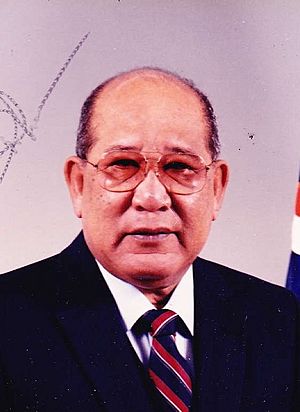Amata Kabua facts for kids
Quick facts for kids
Amata Kabua
|
|
|---|---|
 |
|
| 1st President of the Marshall Islands | |
| In office November 17, 1979 – December 19, 1996 |
|
| Preceded by | Office created |
| Succeeded by | Kunio Lemari |
| President of Senate of Micronesian Congress | |
| In office 1969 – Jan 1973 |
|
| Preceded by | John O. Ngiraked |
| Succeeded by | Tosiwo Nakayama |
| Personal details | |
| Born | November 17, 1928 Jaluit Atoll, Marshall Islands |
| Died | December 19, 1996 (aged 68) Honolulu, Hawaii, U.S. |
| Political party | Independent |
| Spouse | Emlain Kabua |
| Children | 7, including David |
| Relatives | Imata Kabua (cousin) |
Amata Kabua (born November 17, 1928 – died December 19, 1996) was a very important leader for the Marshall Islands. He became the first President of the Marshall Islands in 1979. He served as president for five terms until he passed away in 1996.
Early Life and Family
Amata Kabua came from an important family in the Marshall Islands. His father, Chief Lejolañ Kabua, was a powerful leader from the Western (Ralik) chain of islands. Lejolañ's father was King Kabua the Great. King Kabua was known for making a friendship treaty with Germany in 1885.
Amata's mother, Leroij Dorothy Tarjikit, was also a powerful leader. She came from the Eastern (Ratak) chain of islands. Her family was very important in that area.
Amata's family played a big role in the history of the Marshall Islands.
- His great-grandfather, King Kabua the Great, helped Protestant missionaries in the 1850s. This connected the royal family to the Protestant faith.
- His mother, Tarjikit, helped start the Catholic church in the capital city of the Marshall Islands. This connected the royal family to the Catholic faith.
Amata's parents were also important on the world stage.
- His mother, Tarjikit, was the first local Micronesian person to attend a United Nations meeting. This happened in 1953, and Amata went with her as her interpreter.
- His father, Lejolañ, was the first Marshallese person to visit the White House. He met with President Lyndon B. Johnson.
Career and Presidency
Amata Kabua started his career as a school teacher. Later, he became a Superintendent of Schools. He also worked as a Chief Clerk for the Council of Iroij (a group of chiefs) in the 1950s.
His political career began when he was elected to the Council of Micronesia in 1963. He later became a Senator in the Congress of Micronesia. He even served one term as the president of the Congress of Micronesia.
A very important day for Amata Kabua was November 17, 1979. On his 51st birthday, he became the first President of the Marshall Islands. This was when the country's first constitution was put into action.
After his older brother Joba Kabua died in 1982, Amata Kabua inherited an important title. He became the Iroijlaplap (Paramount Chief) for Majuro Atoll and parts of the Ralik Chain.
Amata Kabua was a key person in helping the Marshall Islands gain full independence. The country became independent in a special agreement with the United States. This agreement is called the Compact of Free Association. Because of his efforts, many Marshallese people see him as the founding father of their modern nation.
He also wrote the words for the national anthem of the Marshall Islands, called "Forever Marshall Islands".
Amata Kabua passed away on December 19, 1996, in Hawaii, after being sick for a long time. He was buried on his family's property in Long Island.
See also
 In Spanish: Amata Kabua para niños
In Spanish: Amata Kabua para niños

